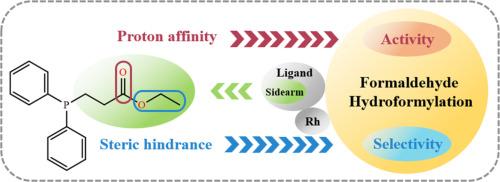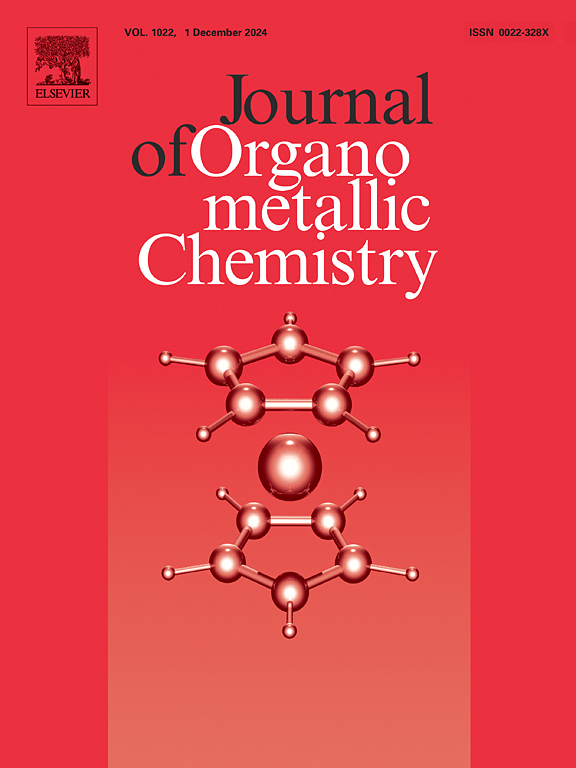用于 Rh 复合物催化的加氢甲酰化的 Sidearm 修饰膦配体:机理途径和结构-活性关系
IF 2.1
3区 化学
Q3 CHEMISTRY, INORGANIC & NUCLEAR
引用次数: 0
摘要
开发高性能膦配体是改善均相氢化甲酰反应的有效策略。本研究设计了一系列具有不同特性(如质子亲和力、立体阻碍)的酰胺/酯侧翼修饰膦配体,用于甲醛氢甲酰化反应中的均相 Rh-络合物。质子亲和力较强的侧矛修饰配体可通过侧矛将质子从氢化铑物种转移到活化的甲醛中,从而生成临界羟甲基铑物种,有利于羟基甲酰化为乙醛,从而显著提高反应速率(是 PPh3 的两倍)。具有较大立体阻碍的大块苷元可以拉伸产物和苷元之间的氢键,从而抑制副产物的产生并提高目标选择性。基于 DFT 计算和实验研究,提出了侧矛修饰膦配体配位 Rh 复合物的潜在反应机制,包括侧矛诱导的去质子化和分子内质子转移。这项研究有助于创新设计具有特殊功能侧耳的膦配体,用于氢甲酰化反应。本文章由计算机程序翻译,如有差异,请以英文原文为准。

Sidearm modified phosphine ligands for Rh complex-catalyzed hydroformylation: Mechanistic pathway and structure-activity relationship
Development of high-performance phosphine ligands is an effectual strategy to improve the homogeneous hydroformylation reaction. This study designed a series of amide/ester sidearms-modified phosphine ligands with different characteristics (e.g., proton affinity, steric hindrance) for homogeneous Rh-complex in hydroformylation of formaldehyde. The sidearms-modified ligands with the stronger proton affinity serve to transfer proton from the hydrido rhodium species to the activated formaldehyde via the sidearms to generate the critical hydroxymethyl rhodium species that favours the hydroformylation to glycolaldehyde, yielding significantly improved reaction rates (twice as much as PPh3). The bulky sidearm with larger steric hindrance can stretch the hydrogen bond between the product and the sidearm, suppressing the by-product production and improving the target selectivity. A potential reaction mechanism involving sidearm-induced deprotonation and inner-molecule proton transfer was proposed for the sidearm-modified phosphine ligands coordinated Rh complex based on the DFT calculation and experimental study. This study can trigger the innovative phosphine ligand design with special functional sidearms for hydroformylation.
求助全文
通过发布文献求助,成功后即可免费获取论文全文。
去求助
来源期刊

Journal of Organometallic Chemistry
化学-无机化学与核化学
CiteScore
4.40
自引率
8.70%
发文量
221
审稿时长
36 days
期刊介绍:
The Journal of Organometallic Chemistry targets original papers dealing with theoretical aspects, structural chemistry, synthesis, physical and chemical properties (including reaction mechanisms), and practical applications of organometallic compounds.
Organometallic compounds are defined as compounds that contain metal - carbon bonds. The term metal includes all alkali and alkaline earth metals, all transition metals and the lanthanides and actinides in the Periodic Table. Metalloids including the elements in Group 13 and the heavier members of the Groups 14 - 16 are also included. The term chemistry includes syntheses, characterizations and reaction chemistry of all such compounds. Research reports based on use of organometallic complexes in bioorganometallic chemistry, medicine, material sciences, homogeneous catalysis and energy conversion are also welcome.
The scope of the journal has been enlarged to encompass important research on organometallic complexes in bioorganometallic chemistry and material sciences, and of heavier main group elements in organometallic chemistry. The journal also publishes review articles, short communications and notes.
 求助内容:
求助内容: 应助结果提醒方式:
应助结果提醒方式:


